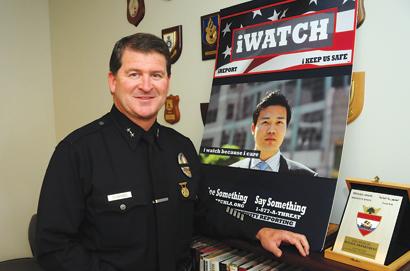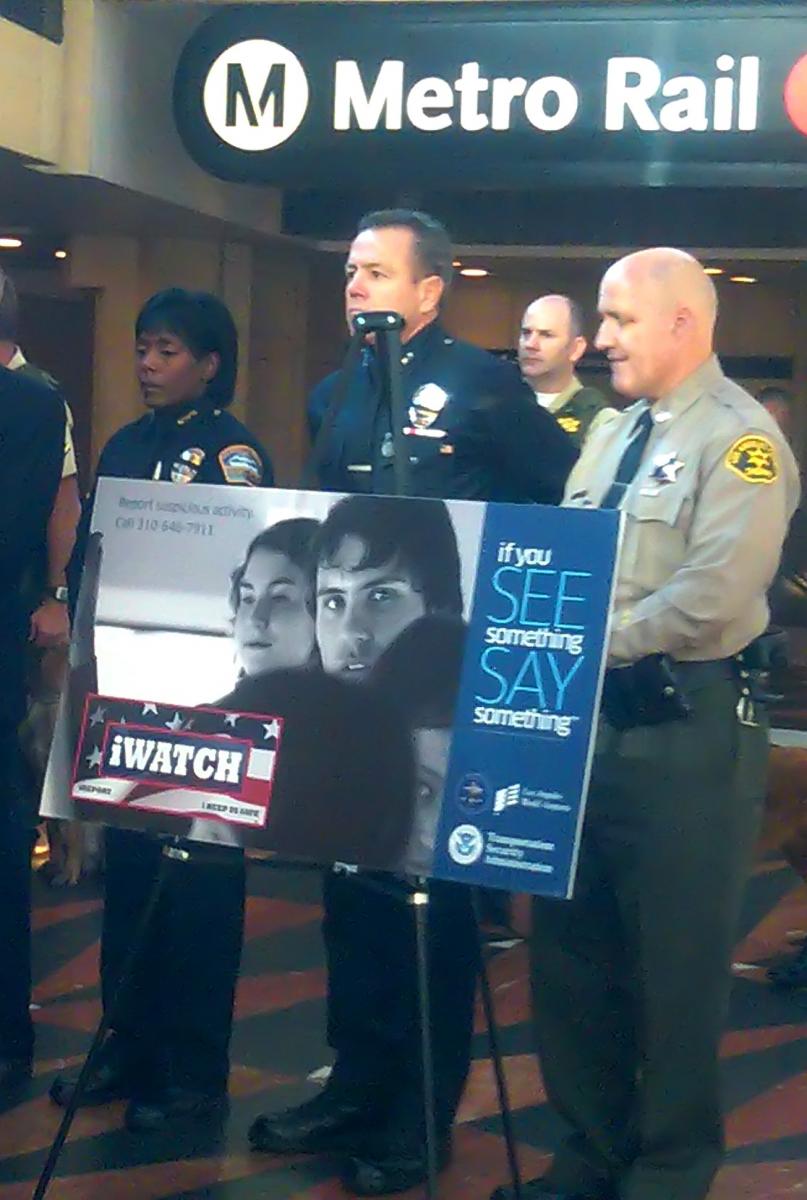The Courage to Speak Up-iWatch
The LAPD enlists the community’s help in a campaign to prevent terrorism at home.
The world is a dangerous place, not because of those who do evil, but because of those who look on and do nothing. —Albert Einstein
What do the names James Cromitie, Faisal Shahzad, and Jose Padilla have in common? Although the three men differ in age, ethnicity, and background, they are forever linked in infamy, each having been convicted of conspiring to commit acts of terrorism on United States soil. Homegrown terrorism is a real and growing threat, and one that predates 9-11. According to a 2010 Homeland Security Solutions report, 86 terrorist plots against U.S. targets were uncovered between 1999 and 2009. Although al-Qaeda-backed plots involving Islamic radicals like Shahzad receive the bulk of the media coverage, they are by no means alone. More than half the plots included in the above-mentioned report originated from individuals or groups without foreign ties. Perpetrators included white supremacists, anti-government/militia groups, and violent special interests (e.g., abortion clinic shooters).
We tend to associate terrorism with Muslim extremism, forgetting that domestic terrorists often follow very different—but equally lethal—agendas (think Timothy McVeigh and Eric Rudolph). What’s more, U.S.-based terrorists pose great danger to society due not only to close proximity to their targets; these chameleons of the terrorist world also blend in with the crowd in terms of dress, speech, and mannerisms. In short, a cookie-cutter terrorist profile simply doesn’t exist.
Everyday citizens play a vital role in helping law enforcement weed out would-be terrorists. In fact, about 40 percent of plots are thwarted thanks to tips from the public and informants. For this reason, the U.S. Department of Homeland Security and law enforcement agencies nationwide are expanding awareness campaigns designed to teach the public how to recognize suspicious activities and behaviors that could be linked to terrorism. The Los Angeles Police Department (LAPD) has taken this effort one step farther with iWATCH, I KEEP US SAFE (iWATCH), a program that connects citizens wishing to report observations directly with the appropriate law enforcement authorities.
What Is iWATCH?
 Dubbed the “21st Century Neighborhood Watch,” iWATCH is a partnership between the community and law enforcement. The program works by encouraging individuals to report suspicious activity to law enforcement officials, who can then determine whether an investigation is warranted. iWATCH differs from national-level awareness campaigns in that it provides local contact information. “When we looked at information sharing and intelligence, we saw a vacuum in local law enforcement as to how to report suspicious activity,” explained Deputy Chief Michael P. Downing, commanding officer of the LAPD Counter-Terrorism and Special Operations Bureau. “People knew how to report gang activity and other crimes but not how to report suspicious activity that might be related to terrorism.”
Dubbed the “21st Century Neighborhood Watch,” iWATCH is a partnership between the community and law enforcement. The program works by encouraging individuals to report suspicious activity to law enforcement officials, who can then determine whether an investigation is warranted. iWATCH differs from national-level awareness campaigns in that it provides local contact information. “When we looked at information sharing and intelligence, we saw a vacuum in local law enforcement as to how to report suspicious activity,” explained Deputy Chief Michael P. Downing, commanding officer of the LAPD Counter-Terrorism and Special Operations Bureau. “People knew how to report gang activity and other crimes but not how to report suspicious activity that might be related to terrorism.”
iWATCH was designed to complement the LAPD’s suspicious activity reporting (SAR) program. Implemented by the department’s Counter-Terrorism Intelligence Bureau in 2007, SAR is part of a nationwide effort to provide law enforcement officers with uniform procedures for collecting, processing, and forwarding information while ensuring the protection of privacy and civil liberties. Launched in 2009, iWATCH brings the public into the fold by encouraging vigilance and assertiveness while streamlining reporting procedures.
Radio, television, and print announcements encourage Los Angeles residents to call an LAPD toll-free number (877-A-THREAT) or visit www.iwatchla.org to report suspicious sightings that could be linked to terrorism. Reports take approximately five minutes to complete, and each is reviewed by departmental personnel trained in counter-terrorism and SAR documentation procedures.
Individuals who wish to report activities occurring outside the Los Angeles city limits but within the metropolitan region are encouraged to call the Joint Regional Intelligence Center (JRIC) at (562) 345-1100. A cooperative venture between the LAPD, the Los Angeles County Sheriff’s Department, the FBI, and the Los Angeles Terrorism Early Warning Group, the JRIC serves as a clearinghouse for possible leads linked to terrorism. The center serves seven area counties: Los Angeles, Orange, Riverside, San Bernardino, Ventura, Santa Barbara, and San Luis Obispo.
Something Strange Going On
 What constitutes “suspicious” behavior? In the fight against terrorism, it may involve perfectly legal actions that seem out of context or trigger a gut feeling that something just isn’t quite right. During an interview with former LAPD Chief William Bratton, National Public Radio host Neal Conan cited the case of Najibullah Zazi as an example. Denver-area beauty supply store clerks became suspicious and contacted the police after Zazi made several large purchases of household chemicals, stating that he had “a lot of girlfriends.” Authorities later arrested the Afghan-born U.S. resident, who was found to have undergone explosives training at a Pakistan terrorist camp and was charged for taking part in an al-Qaeda plot to commit suicide bombings in the New York subway. In February 2010, Zazi pled guilty to conspiring to use weapons of mass destruction, conspiracy to commit murder in a foreign country, and providing material support to a terrorist organization.
What constitutes “suspicious” behavior? In the fight against terrorism, it may involve perfectly legal actions that seem out of context or trigger a gut feeling that something just isn’t quite right. During an interview with former LAPD Chief William Bratton, National Public Radio host Neal Conan cited the case of Najibullah Zazi as an example. Denver-area beauty supply store clerks became suspicious and contacted the police after Zazi made several large purchases of household chemicals, stating that he had “a lot of girlfriends.” Authorities later arrested the Afghan-born U.S. resident, who was found to have undergone explosives training at a Pakistan terrorist camp and was charged for taking part in an al-Qaeda plot to commit suicide bombings in the New York subway. In February 2010, Zazi pled guilty to conspiring to use weapons of mass destruction, conspiracy to commit murder in a foreign country, and providing material support to a terrorist organization.
Zazi’s unusual purchases and implausible explanation raised red flags that helped investigators foil a possibly deadly attack. The LAPD encourages citizens to be alert to similar activities and report the following types of suspicious behavior and events, especially if they occur in or near government buildings, sports or entertainment venues, public transportation, bridges, or other high-density locations:
- People drawing, measuring, or photographing important buildings
- Briefcases, suitcases, backpacks, or packages left behind
- Vehicles left in no-parking zones in front of important buildings
- Intruders in secure areas
- Peculiar chemical smells or fumes
- People asking questions about sensitive information such as security procedures, building blueprints, security plans, or executive travel schedules without a legitimate need to know
- Individuals purchasing supplies or equipment that could be used to make weapons
- Individuals purchasing uniforms without proper credentials.
- Building Public Trust
When first introduced, the iWATCH concept was met with skepticism by some city groups. Today, the program enjoys broad-based support thanks to the efforts of the LAPD and its Counter-Terrorism and Special Operations Bureau to include all segments of the community in the planning and evaluation processes. “There were initially a lot of trust issues in the community,” explained Downing. “They wanted to make sure we would not violate anyone’s civil rights and that there were no racial profiling concerns.” Downing and his staff worked with L.A.’s interfaith communities and with members of the city public affairs council, who were invited on a station-by-station tour of the LAPD headquarters and given the opportunity to critique the draft program and provide recommendations.
Downing stresses that iWATCH is intended to uncover suspicious activities—not single out individuals by sex, ethnicity, or race. “We are asking the public to help support the Constitution and protect our neighborhoods against the people who prey on them. It’s the antithesis of profiling. It has everything to do with watching for behavior that might be damaging to the neighborhood.”
Flying High at LAX… and Beyond
 On June 3, 2010, iWATCH was expanded to encompass Los Angeles International Airport. During program promotion, airport officials distributed pamphlets encouraging travelers to report suspicious occurrences, such as luggage or vehicles left unattended. The pamphlets included an emergency airport police telephone number in addition to the central iWATCH contact number.
On June 3, 2010, iWATCH was expanded to encompass Los Angeles International Airport. During program promotion, airport officials distributed pamphlets encouraging travelers to report suspicious occurrences, such as luggage or vehicles left unattended. The pamphlets included an emergency airport police telephone number in addition to the central iWATCH contact number.
A growing number of organizations outside Los Angeles also are establishing terrorism-prevention programs based on the LAPD model. “Working with the major cities’ police chiefs, the LAPD began introducing the iWATCH program to law enforcement agencies nationwide about a year ago,” said Mary Grady, LAPD public information director. “The LAPD offers marketing materials, including brochures, posters, PSAs, and a community training video free of charge to any agency that wants to begin its own program. We have also put together a step-by-step instruction for creating an iWATCH webpage on any agency website.” The police departments of Dallas, Boston, Washington, D.C., Baltimore, and Long Beach, California, have already launched or will soon launch their own iWATCH programs. Additionally, the U.S. Army adopted iWATCH about five months ago, and the U.S. Navy is now studying the program. Notable private organizations using iWATCH include the National Basketball Association, which rolled out its campaign during the 2011 NBA All-Star Jam Session this past February.
The examples above illustrate how law enforcement, community groups, and public and private organizations alike can—and should—implement terrorism prevention programs such as iWATCH. Furthermore, Deputy Chief Downing stresses that terrorism prevention is everyone’s business, not just a big city concern. “It is just as important, if not more important, for small communities. Although terrorists often target big cities, they might be making plans in a small town or buying suspicious supplies from a suburban business.” Downing recommends that Neighborhood Watch groups add terrorism prevention to their meeting agendas, as well as invite officers from counter-terrorism units to attend meetings to discuss threats and teach members how to properly report suspicious activities so that law enforcement can develop actionable intelligence. “Just as you build crime resistance in your neighborhood, you can create hostile environments for terrorists so that we can prevent attacks.”
For Further Information:
- Los Angeles County Sheriff’s Department
- LAPD Facebook Page
- iWATCH Homepage
- LAPD Neighborhood Watch Info
Multimedia:
- “iWATCH lets public report suspicious behavior,” Los Angeles News
- iWATCH Community Training Film
- U.S. Department of Homeland Security “If You See Something, Say Something” public awareness video
- New York Metropolitan Transit Authority (program information from the organization that founded the original “If You See Something, Say Something”)



